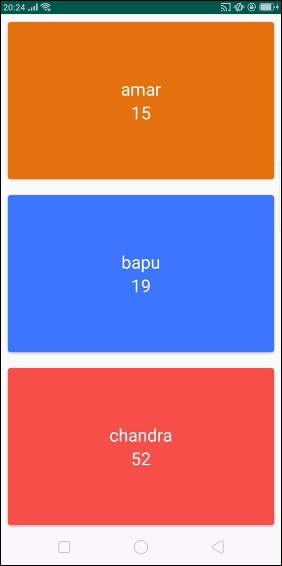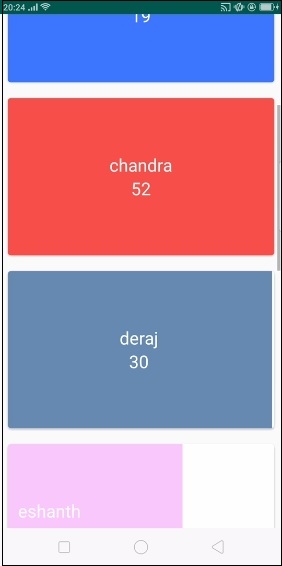
 Data Structure
Data Structure Networking
Networking RDBMS
RDBMS Operating System
Operating System Java
Java MS Excel
MS Excel iOS
iOS HTML
HTML CSS
CSS Android
Android Python
Python C Programming
C Programming C++
C++ C#
C# MongoDB
MongoDB MySQL
MySQL Javascript
Javascript PHP
PHP
- Selected Reading
- UPSC IAS Exams Notes
- Developer's Best Practices
- Questions and Answers
- Effective Resume Writing
- HR Interview Questions
- Computer Glossary
- Who is Who
Recycler view item animate when scrolling in Android
Before getting into Item animation for recycler view example, we should know what is Recycler view in android. Recycler view is a more advanced version of the list view and it works based on View holder design pattern. Using recycler view we can show grids and list of items.
card view is extended by frame layout and it is used to show items in card manner. It supports radius and shadow as predefined tags.
This example demonstrates how to integrate Animation in Recycler View with card view by creating a beautiful student records app that displays student name with age.
Step 1 ? Create a new project in Android Studio, go to File ? New Project and fill all required details to create a new project.
Step 2 ? Open build.gradle and add Recycler view and card view library dependencies.
apply plugin: 'com.android.application'
android {
compileSdkVersion 28
defaultConfig {
applicationId "com.example.andy.tutorialspoint"
minSdkVersion 19
targetSdkVersion 28
versionCode 1
versionName "1.0"
testInstrumentationRunner "android.support.test.runner.AndroidJUnitRunner"
}
buildTypes {
release {
minifyEnabled false
proguardFiles getDefaultProguardFile('proguard-android.txt'), 'proguard-rules.pro'
}
}
}
dependencies {
implementation fileTree(dir: 'libs', include: ['*.jar'])
implementation 'com.android.support:appcompat-v7:28.0.0'
implementation 'com.android.support:design:28.0.0'
implementation 'com.android.support.constraint:constraint-layout:1.1.3'
implementation 'com.android.support:cardview-v7:28.0.0'
implementation 'com.android.support:recyclerview-v7:28.0.0'
testImplementation 'junit:junit:4.12'
androidTestImplementation 'com.android.support.test:runner:1.0.2'
androidTestImplementation 'com.android.support.test.espresso:espresso-core:3.0.2'
}
Step 3 ? Add the following code to res/layout/activity_main.xml.
<?xml version = "1.0" encoding="utf-8"?> <RelativeLayout xmlns:android = "http://schemas.android.com/apk/res/android" xmlns:tools = "http://schemas.android.com/tools" xmlns:app =" http://schemas.android.com/apk/res-auto android:layout_width = "match_parent" android:layout_height = "match_parent" app:layout_behavior = "@string/appbar_scrolling_view_behavior" tools:showIn = "@layout/activity_main" tools:context = ".MainActivity"> <android.support.v7.widget.RecyclerView android:id = "@+id/recycler_view" android:layout_width = "match_parent" android:layout_height = "wrap_content" android:scrollbars = "vertical" /> </RelativeLayout>
In the above code we have added recycler view to window manger as relative parent layout.
Step 4 ? Add the following code to src/MainActivity.java
package com.example.andy.tutorialspoint;
import android.annotation.TargetApi;
import android.os.Build;
import android.os.Bundle;
import android.support.annotation.RequiresApi;
import android.support.v7.app.AppCompatActivity;
import android.support.v7.widget.DividerItemDecoration;
import android.support.v7.widget.GridLayoutManager;
import android.support.v7.widget.LinearLayoutManager;
import android.support.v7.widget.RecyclerView;
import android.widget.LinearLayout;
import java.util.ArrayList;
import java.util.Collections;
import java.util.Comparator;
import java.util.List;
public class MainActivity extends AppCompatActivity {
private RecyclerView recyclerView;
private StudentAdapter studentAdapter;
private List<studentData> studentDataList = new ArrayList<>();
@TargetApi(Build.VERSION_CODES.O)
@Override
protected void onCreate(Bundle savedInstanceState) {
super.onCreate(savedInstanceState);
setContentView(R.layout.activity_main);
recyclerView = findViewById(R.id.recycler_view);
studentAdapter = new StudentAdapter(studentDataList,MainActivity.this);
RecyclerView.LayoutManager manager = new LinearLayoutManager(this);
recyclerView.setLayoutManager(manager);
recyclerView.setAdapter(studentAdapter);
StudentDataPrepare();
}
@RequiresApi(api = Build.VERSION_CODES.N)
private void StudentDataPrepare() {
studentData data = new studentData("sai", 25);
studentDataList.add(data);
data = new studentData("sai", 25);
studentDataList.add(data);
data = new studentData("raghu", 20);
studentDataList.add(data);
data = new studentData("raj", 28);
studentDataList.add(data);
data = new studentData("amar", 15);
studentDataList.add(data);
data = new studentData("bapu", 19);
studentDataList.add(data);
data = new studentData("chandra", 52);
studentDataList.add(data);
data = new studentData("deraj", 30);
studentDataList.add(data);
data = new studentData("eshanth", 28);
studentDataList.add(data);
Collections.sort(studentDataList, new Comparator() {
@Override
public int compare(studentData o1, studentData o2) {
return o1.name.compareTo(o2.name);
}
});
}
}
In the above code we have added recycler view and studentAdapter. In that student adapter we have passed studentDatalist as arraylist. In Student data list contains name of the student and age.
To compare recycler view items we have used collections framework and sort method as shown below -
Collections.sort(studentDataList, new Comparator() {
@Override
public int compare(studentData o1, studentData o2) {
return o1.name.compareTo(o2.name);
}
});
In the above code we are comparing elements by using name.
Step 5 ? Following is the content of the modified file src/ StudentAdapter.java.
package com.example.andy.tutorialspoint;
import android.content.Context;
import android.graphics.Color;
import android.support.annotation.NonNull;
import android.support.v7.widget.RecyclerView;
import android.view.LayoutInflater;
import android.view.View;
import android.view.ViewGroup;
import android.view.animation.AlphaAnimation;
import android.view.animation.Animation;
import android.view.animation.AnimationUtils;
import android.widget.LinearLayout;
import android.widget.TextView;
import java.util.List;
import java.util.Random;
class StudentAdapter extends RecyclerView.Adapter {
List studentDataList;
Context context;
private int lastPosition = -1;
public StudentAdapter(List studentDataList, Context context) {
this.studentDataList=studentDataList;
this.context=context;
}
@NonNull
@Override
public MyViewHolder onCreateViewHolder(@NonNull ViewGroup viewGroup, int i) {
View itemView = LayoutInflater.from(viewGroup.getContext())
.inflate(R.layout.student_list_row, viewGroup, false);
return new MyViewHolder(itemView);
}
@Override
public void onBindViewHolder(MyViewHolder viewHolder, int i) {
studentData data=studentDataList.get(i);
Random rnd = new Random();
int currentColor = Color.argb(255, rnd.nextInt(256), rnd.nextInt(256), rnd.nextInt(256));
viewHolder.parent.setBackgroundColor(currentColor);
viewHolder.name.setText(data.name);
viewHolder.age.setText(String.valueOf(data.age));
setAnimation(viewHolder.parent, i);
}
private void setAnimation(View viewToAnimate, int position) {
// If the bound view wasn't previously displayed on screen, it's animated
if (position > lastPosition) {
Animation animation = AnimationUtils.loadAnimation(context, android.R.anim.slide_in_left);
viewToAnimate.startAnimation(animation);
lastPosition = position;
}
}
@Override
public int getItemCount() {
return studentDataList.size();
}
class MyViewHolder extends RecyclerView.ViewHolder {
TextView name,age;
LinearLayout parent;
public MyViewHolder(View itemView) {
super(itemView);
parent = itemView.findViewById(R.id.parent);
name = itemView.findViewById(R.id.name);
age = itemView.findViewById(R.id.age);
}
}
}
In the adapter class, we have four methods as shown below -
-
onCreateViewHolder():- It is used to create a view holder and it returns a view.
-
onBindViewHolder() - it going to bind with created view holder.
-
getItemCount() - it contains size of list.
-
MyViewHolder class- it is view holder inner class which is extended by RecyclerView.ViewHolder
To set the random background for recycler view items, we have generated random colors using random class(which is predefined class in Android) and added color to the parent of view item as shown below -
Random rnd = new Random(); int currentColor = Color.argb(255, rnd.nextInt(256), rnd.nextInt(256), rnd.nextInt(256)); viewHolder.parent.setBackgroundColor(currentColor);
In the adapter we have used setAnimation(), in that method we have passed, parent of child item and its position as shown below -
setAnimation(viewHolder.parent, i);
In the above method viewHolder.parent is linear layout in the child item layout and "i" is position of the view.
private void setAnimation(View viewToAnimate, int position)
{
// If the bound view wasn't previously displayed on screen, it's animated
if (position > lastPosition)
{
Animation animation = AnimationUtils.loadAnimation(context, android.R.anim.slide_in_left);
viewToAnimate.startAnimation(animation);
lastPosition = position;
}
}
In the above method we are comparing current position with last position using greater than(>), than we are applying animation from AnimationUtils Class.
Step 6 ? Following is the modified content of the xml res/layout/student_list_row.xml.
<?xml version = "1.0" encoding = "utf-8"?> <android.support.v7.widget.CardView xmlns:android = "http://schemas.android.com/apk/res/android" xmlns:card_view = "http://schemas.android.com/apk/res-auto" android:layout_width = "match_parent" card_view:cardCornerRadius = "4dp" android:id = "@+id/card_view" android:layout_margin = "10dp" android:layout_height = "200dp"> <LinearLayout android:id = "@+id/parent" android:layout_gravity = "center" android:layout_width = "match_parent" android:orientation = "vertical" android:gravity = "center" android:layout_height = "match_parent"> <TextView android:id = "@+id/name" android:layout_width = "wrap_content" android:gravity = "center" android:textSize = "25sp" android:textColor = "#FFF" android:layout_height = "wrap_content" /> <TextView android:id = "@+id/age" android:layout_width = "wrap_content" android:gravity = "center" android:textSize = "25sp" android:textColor = "#FFF" android:layout_height = "wrap_content" /> </LinearLayout> </android.support.v7.widget.CardView>
In the above list item view we have created two text views for name and age inside the card view. Card view contains pre defined corner radius and shadow property. So we have used corner radius with cardview.
Step 7 ? Following is the content of the modified file src/ studentData.java.
package com.example.andy.tutorialspoint;
class studentData {
String name;
int age;
public studentData(String name, int age) {
this.name = name;
this.age = age;
}
}
In the above code informs about student data object. Let's try to run your application. I assume you have connected your actual Android Mobile device with your computer. To run the app from android studio, open one of your project's activity files and click Run  icon from the toolbar. Select your mobile device as an option and then check your mobile device which will display your default screen ?
icon from the toolbar. Select your mobile device as an option and then check your mobile device which will display your default screen ?

Now scroll down to the recyclerview, it will show the result as shown below -

Now see the last element, it is loading with animations. There are more reference samples available as shown below -
Click here to download the project code

